Potential Invader
coconut rhinoceros beetles
Family: Scarabaeidae Subfamily: Dynastinae Genus: Oryctes
none available
Scarabs of the genus Oryctes are somewhat uniform in color and armature, but more variable in body shape. Body length ranges between 22.0–77.0 mm (0.86–3.03 in). The body form of these beetles is usually convex dorsally, but varies from elongate and somewhat cylindrical to oblong and weakly flattened dorsoventrally. Color is more uniform, ranging from dark brown to black. While the size of the cephalic horn varies considerably between species, horn shape is similar with all males (and females in many species) having a single, unbranched (ending in one point), curved horn. In many species, sexes can be differentiated based upon the cephalic horn, with females either lacking horns or with a reduced horn. The form of the ocular canthuscanthus:
a process extending over and sometimes dividing the eye
is variable, being simple in some species or quadrately produced in others. Both males and females of most species possess a broad, sculpted depression on the pronotumpronotum:
the dorsal surface of the thorax
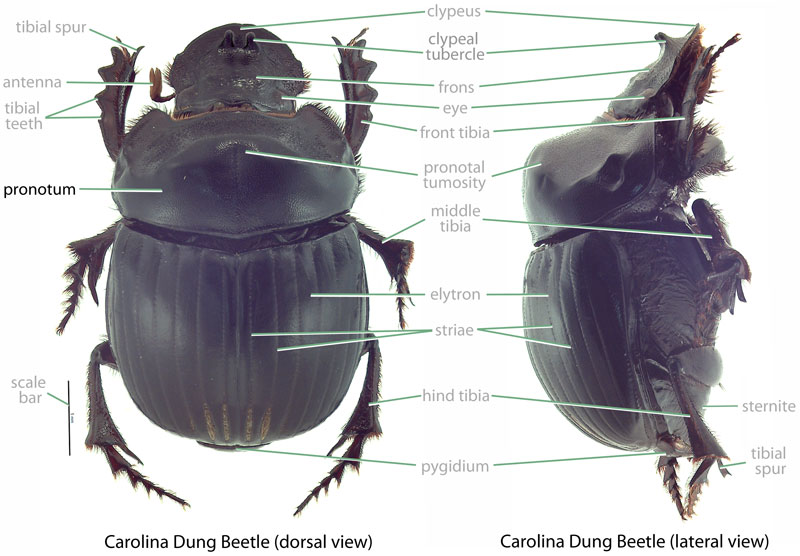 .
.
Undescribed at the generic level. For Dynastinae (Ritcher, 1966Ritcher, 1966:
Ritcher P. 1966. White grubs and their allies: a study of North American scarabaeoid larvae. Oregon State University Monographs, Studies in Entomology 4: 1-219.): When alive, larvaelarvae:
the immature form of an insect; in scarabs, also called grub or white grub; preceded by the egg stage, followed by the pupal stage
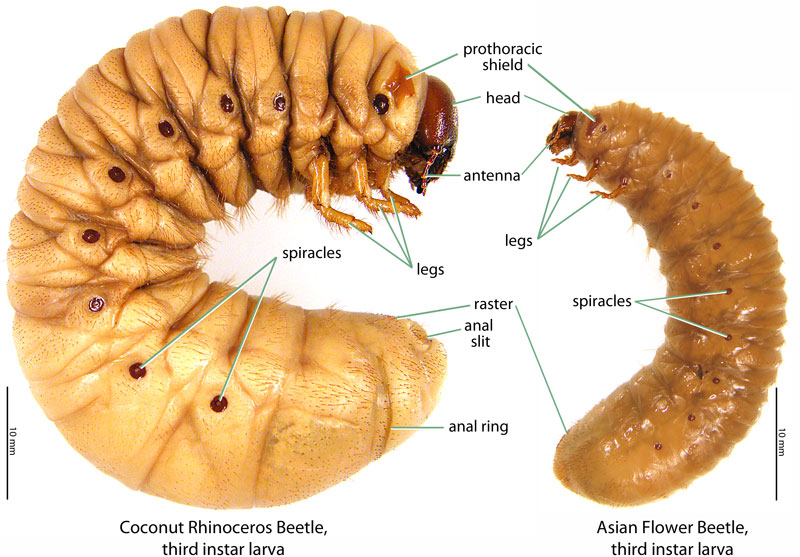 are firm to the touch (not distinctly "squishy" as in Protaetia spp. with which they may be confused), and they are not able to crawl on their back (a characteristic of Protaetia spp.). Grub C-shaped, not hump-backed, cylindrical, whitish. Maxillamaxilla:
are firm to the touch (not distinctly "squishy" as in Protaetia spp. with which they may be confused), and they are not able to crawl on their back (a characteristic of Protaetia spp.). Grub C-shaped, not hump-backed, cylindrical, whitish. Maxillamaxilla:
set of paired mouthparts located posterior to the mandibles
with galeagalea:
outer branch or lobe of the maxilla
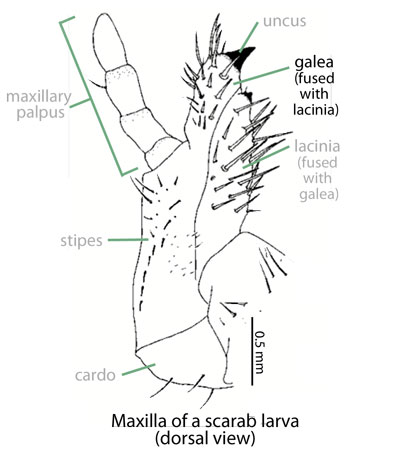 and lacinialacinia:
and lacinialacinia:
inner portion of the maxilla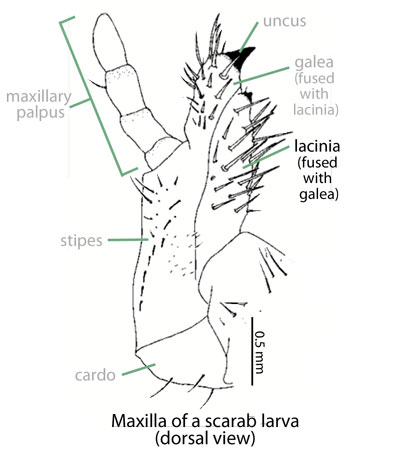 fused or nearly so. Lacinialacinia:
fused or nearly so. Lacinialacinia:
inner portion of the maxilla of maxillamaxilla:
of maxillamaxilla:
set of paired mouthparts located posterior to the mandibles
with 3 well-developed unciunci:
in scarab larvae, a hooked process on the distal margin of the maxilla
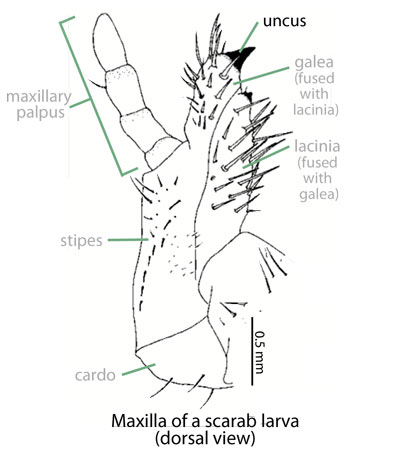 . Maxillary stridulatory teeth truncatetruncate:
. Maxillary stridulatory teeth truncatetruncate:
appearing cut-off or suddenly shortened
. Legs 4-segmented. Anal opening transversetransverse:
extending horizontally across a surface
, straight to slightly curved. PlegmatiaPlegmatia:
in scarab larvae, a paired, lateral region with a somewhat sclerotized surface bordered by marginal spines with acanthoparia
 absent.
absent.
Old World. Oryctes spp. are distributed widely across the Old World. Species are distributed from western Europe and Scandinavia southward to the African Cape region and eastward across Asia to the Pacific islands (Dechambre and Lachaume, 2001Dechambre and Lachaume, 2001:
Dechambre R and Lachaume G. 2001. Oryctes . Les Coleopteres du Monde 27: 1-72. Hillside Books, Canterbury, UK.).
Many members of this genus are associated with palms (Dechambre and Lachaume, 2001Dechambre and Lachaume, 2001:
Dechambre R and Lachaume G. 2001. Oryctes . Les Coleopteres du Monde 27: 1-72. Hillside Books, Canterbury, UK.) including economically important species such as African oil palm (Elaeis guineensis) and coconut palm (Cocos nucifera) (Molet, 2013Molet, 2013:
Molet T. 2013. CPHST pest datasheet for Oryctes rhinoceros . USDA-APHIS-PPQ-CPHST. Available from https://caps.ceris.purdue.edu/webfm_send/2206 (accessed April 9 2015).). Both Oryctes rhinoceros and Oryctes monocerus damage a range of palm and non-palm plant species (Bedford, 2015Bedford, 2015:
Bedford G. 2015. Oryctes rhinoceros (coconut rhinoceros beetle). Invasive Species Compendium. Wallingford, UK, CABI International. Available from http://www.cabi.org/isc/datasheet/37974 (accessed 2015).; Dechambre and Lachaume, 2001Dechambre and Lachaume, 2001:
Dechambre R and Lachaume G. 2001. Oryctes . Les Coleopteres du Monde 27: 1-72. Hillside Books, Canterbury, UK.). Oryctes rhinoceros in particular, is known to attack non-palms such as the Alexandria laurel (Calophyllum inophyllum), banana (Musa spp.), breadfruit (Artocarpus spp.), mango (Mangifera spp.), pineapple (Ananas comosus), and sugarcane (Saccharum spp.) (Molet, 2013Molet, 2013:
Molet T. 2013. CPHST pest datasheet for Oryctes rhinoceros . USDA-APHIS-PPQ-CPHST. Available from https://caps.ceris.purdue.edu/webfm_send/2206 (accessed April 9 2015).).
While details vary between species, members of this genus are fairly uniform in terms of general life history (Dechambre and Lachaume, 2001Dechambre and Lachaume, 2001:
Dechambre R and Lachaume G. 2001. Oryctes . Les Coleopteres du Monde 27: 1-72. Hillside Books, Canterbury, UK.). Females deposit eggs in burrows dug into mulch, decaying vegetation, manure-rich soils, or soft, rotten wood. Standing, dead palms may be used as breeding sites, as well as rotten plant matter caught in the petiolespetioles:
stalk of a leaf
of living palms. LarvaeLarvae:
the immature form of an insect; in scarabs, also called grub or white grub; preceded by the egg stage, followed by the pupal stage
 feed on organic debris within the nesting medium. Development of the pest species, Oryctes rhinoceros,takes 101–170 days from egg to adult emergence (Molet, 2013Molet, 2013:
feed on organic debris within the nesting medium. Development of the pest species, Oryctes rhinoceros,takes 101–170 days from egg to adult emergence (Molet, 2013Molet, 2013:
Molet T. 2013. CPHST pest datasheet for Oryctes rhinoceros . USDA-APHIS-PPQ-CPHST. Available from https://caps.ceris.purdue.edu/webfm_send/2206 (accessed April 9 2015).).
Severe. Though most of the 43 described species (Dechambre and Lachaume, 2001Dechambre and Lachaume, 2001:
Dechambre R and Lachaume G. 2001. Oryctes . Les Coleopteres du Monde 27: 1-72. Hillside Books, Canterbury, UK.) of this genus are not considered pests, both Oryctes rhinoceros (Molet, 2013Molet, 2013:
Molet T. 2013. CPHST pest datasheet for Oryctes rhinoceros . USDA-APHIS-PPQ-CPHST. Available from https://caps.ceris.purdue.edu/webfm_send/2206 (accessed April 9 2015).) and Oryctes monocerus (Allou et al., 2006Allou et al., 2006:
Allou K, Morin J, Kouassi P, N'klo F, Rochat D. 2006. Oryctes monoceros trapping with synthetic pheromone and palm material in Ivory Coast. Journal of Chemical Ecology 32: 1743-1754) cause severe damage to palms and other host plants. Damage is caused when adults bore into the crowns of the host plant, burrowing as deep as 50 cm (19.7 in) into the hosts tissue (Molet, 2013Molet, 2013:
Molet T. 2013. CPHST pest datasheet for Oryctes rhinoceros . USDA-APHIS-PPQ-CPHST. Available from https://caps.ceris.purdue.edu/webfm_send/2206 (accessed April 9 2015).). This results in destruction of unopened leaves and often the leaf midrib (Molet, 2013Molet, 2013:
Molet T. 2013. CPHST pest datasheet for Oryctes rhinoceros . USDA-APHIS-PPQ-CPHST. Available from https://caps.ceris.purdue.edu/webfm_send/2206 (accessed April 9 2015).). After feeding on the juices produced by damaged host tissue, the beetle bores out of the host plant, often through the base of a frond (Molet, 2013Molet, 2013:
Molet T. 2013. CPHST pest datasheet for Oryctes rhinoceros . USDA-APHIS-PPQ-CPHST. Available from https://caps.ceris.purdue.edu/webfm_send/2206 (accessed April 9 2015).). Plants, particularly young plants, can be killed either when the scarab damages the apical meristem or via secondary infection in the feeding burrow (Hinckley, 1973Hinckley, 1973:
Hinckley A. 1973. Ecology of the coconut rhinoceros beetle, Oryctes rhinoceros (L.) (Coleoptera: Dynastidae). Biotropica 5: 111-116.). In Palau, Gressitt (1953) attributed coconut mortality rates of 50% to damage caused by Oryctes rhinoceros. In Zanzibar, Mansfield-Aders (1920) reported that at some palm plantations, Oryctes monocerus killed over 50% of all young coconut palms.
Established. In Hawaii, Oryctes rhinoceros is currently established on Oahu where it was first detected in December 2013 on Pearl Harbor-Hickam Joint Base (Hawaii Department of Agriculture, 2014Hawaii Department of Agriculture, 2014:
Anonymous. 2014. Destructive beetles found on Oahu coconut trees. Hawaii Department of Agriculture. Available from http://hdoa.hawaii.gov/blog/main/crb/ (accessed May 21 2015).). Efforts are underway to eradicate the scarab and prevent its spread from Oahu. It is likely that this destructive beetle reached Hawaii by hitchhiking on military aircraft flying to Oahu from military bases on Guam, a known transportation pathway for several other invasiveinvasive:
a species that has recently arrived to a new location, usually via human activity, causing notable economic and/or ecological damage
scarabs (Moore, 2012Moore, 2012:
Moore A. 2012. Guam as a source of new insects for Hawaii. Pacific Entomology Conference, Portland, Oregon 2012. Available from http://guaminsects.myspecies.info/sites/guaminsects.myspecies.info/files/GuamHawaiiBugConnection.pdf (accessed 2015).).
Established. In Guam, Oryctes rhinoceros has been established since approximately 2007, when specimens were found in the Tumon Bay area (Moore, 2007Moore, 2007:
Moore A. 2007. Assessment of the Rhinoceros Beetle Infestation on Guam. Available from: http://guaminsects.myspecies.info/assessment-rhinoce-beetle-infestation-guam (accessed May 19 2015).). The species has since spread to the remainder of the island.
The best known and probably most destructive member of the genus is the highly invasiveinvasive:
a species that has recently arrived to a new location, usually via human activity, causing notable economic and/or ecological damage
Oryctes rhinoceros (the coconut rhinoceros beetle). Oryctes rhinoceros has been intercepted in quarantine on multiple occasions, with at least five U.S. interceptions known (Molet, 2013Molet, 2013:
Molet T. 2013. CPHST pest datasheet for Oryctes rhinoceros . USDA-APHIS-PPQ-CPHST. Available from https://caps.ceris.purdue.edu/webfm_send/2206 (accessed April 9 2015).). Adults have been recorded on military equipment, air cargo, coconut "material", and potted plants (Molet, 2013Molet, 2013:
Molet T. 2013. CPHST pest datasheet for Oryctes rhinoceros . USDA-APHIS-PPQ-CPHST. Available from https://caps.ceris.purdue.edu/webfm_send/2206 (accessed April 9 2015).; Bedford, 2015Bedford, 2015:
Bedford G. 2015. Oryctes rhinoceros (coconut rhinoceros beetle). Invasive Species Compendium. Wallingford, UK, CABI International. Available from http://www.cabi.org/isc/datasheet/37974 (accessed 2015).). It has also been reported that larvaelarvae:
the immature form of an insect; in scarabs, also called grub or white grub; preceded by the egg stage, followed by the pupal stage
 are able to survive in floating logs out at sea (Molet, 2013Molet, 2013:
are able to survive in floating logs out at sea (Molet, 2013Molet, 2013:
Molet T. 2013. CPHST pest datasheet for Oryctes rhinoceros . USDA-APHIS-PPQ-CPHST. Available from https://caps.ceris.purdue.edu/webfm_send/2206 (accessed April 9 2015).). Any location where palms grow should be considered at risk for invasion by Oryctes species.
These large scarabs could be confused with the similarly sized and colored Japanese rhinoceros beetle (Trypoxylus dichotomus) and Xylotrupes species. Males of these scarabs can readily be separated by examining of the head horn (Oryctes with single, unbranched horn [ending in single point] versus Xylotrupes with the horn bifurcatebifurcate:
a process dividing into two points
[ending in two points] versus T. dichotomus with the horn doubly bifurcatebifurcate:
a process dividing into two points
[ending in four points]). Females are separated by examining the pronotumpronotum:
the dorsal surface of the thorax
 (Oryctes rhinoceros with a broad, sculpted depression versus Xylotrupes without a depression or foveafovea:
(Oryctes rhinoceros with a broad, sculpted depression versus Xylotrupes without a depression or foveafovea:
a depressed pit or indentation
and T. dichotomus with a distinct, vertical foveafovea:
a depressed pit or indentation
).
Ryanoryctes
In Hawaii, this members of this genus represents new invasiveinvasive:
a species that has recently arrived to a new location, usually via human activity, causing notable economic and/or ecological damage
species. Prevent the spread of this species by reporting your observation at our iNaturalist project.